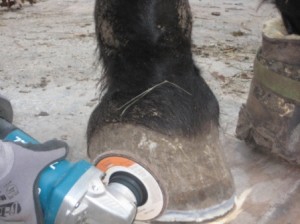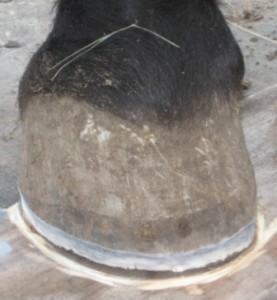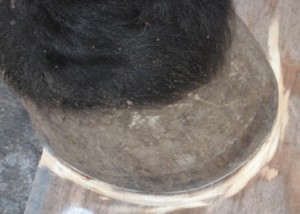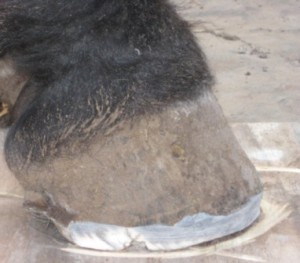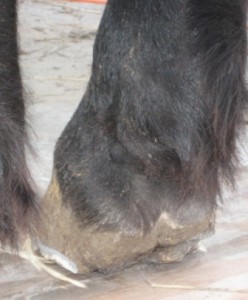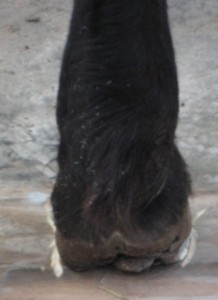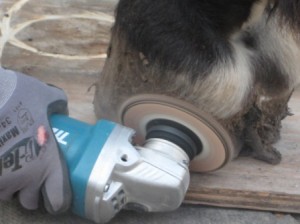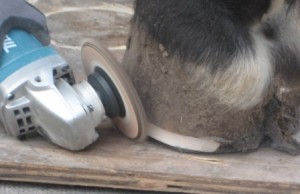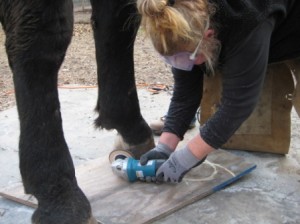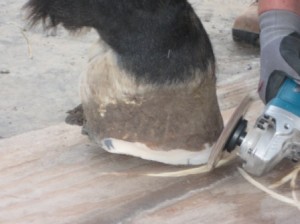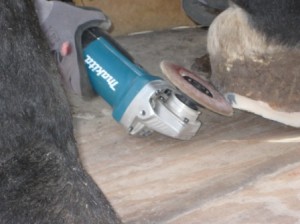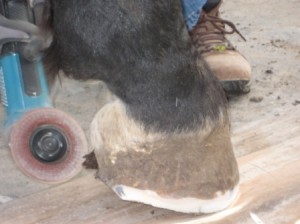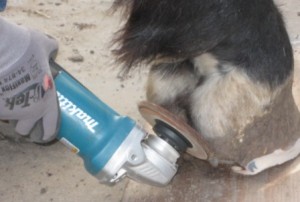So much about thin soles is the trim, providing adequate sole protection while sole develops and getting the nutrition right…
What Is “Normal”???
When you start discussing thin soles, you need to remember that sole thickness varies widely based on age, breed, hoof care history, diet – everything is relative!
According to several vet friends, most “normal” horses have thin soles… 10mm is supposed to be average, but 6-8mm may be more “normal”.
Normal for most horses is quite thin relative to a mustang on soft range! Thick soles like we see in some walking horses and mustangs are not normal for most breeds or horses, and exceptions even exist in the gaited horse breeds… sole thickness varies widely, period.
Thick Sole Isn’t Always Good
I have been able to get a very thick sole to accumulate using Epona synthetic shoes, but it sheds back to “normal” once the horse is left barefoot. My friend Asa, in Las Vegas, hates thick sole because in her arid region, it needs to me trimmed out.
Too much of a good thing is a bad thing.
Rehabbing A Thin Sole?
If a horse has a sole that isn’t worn or trimmed to be thin, and you leave a more stout wall &/or protect the sole from wear, then feed a better diet (see www.drkellon.com ! ) and use something like Keratex or Hoof Armor, you may be able to add 1 to 4 mm. Maybe!
In a case where the sole is already a a relatively healthy depth, and the wall height is good, you may not be able to get much improvement.
If a horse has worn his sole thin because his walls have been trimmed or worn short, like most of the thin soled horses I see, or if the sole has been thinned in the trimming process, you can almost always get more sole to accumulate by tweaking the trim, diet and protection. Here’s my checklist:
- balance the minerals www.drkellon.com
- Feed straight grass hay (take away alfalfa and oat)
- boot 24×7 or glue on synthetic shoes or boot shells
- add boots for all exercise if left barefoot
- change the environment to be non abrasive ; add soft dirt, saw dust, move to a soft pasture
- change the trim technique to NOT trim sole and to let the walls get to be 1/8 to 1/4″ beyond the sole
- Try Keratex applied daily. http://www.keratex.net/hoof_hardener.htm “Keratex Hoof Hardener is a gentle acting chemical formulation which forms additional intermolecular bonds between molecules of keratin through the process of cross-linking. Keratin is the main protein constituent of horn and is best described as the building block of the horn structure.”
- Try Hoof Armor http://www.hoofarmor.com/ “Hoof Armor® hoof protection is an easily applied adhesive coating that Farriers and horse owners alike can utilize to protect their barefoot horse’s hooves against abrasion and wear.”
“Normal”???
Again, what is normal for one breed or individual, like a typical Gaited horse or Morgan, would be very thick for a TB or some lines of QH. Sole depth varies. My Marcel, a never shod Arab, has TB type feet, a thinner sole that often needs more protection.
Should You Worry?
I only worry when the horse is uncomfortable in its living environment.
I used Hoof Armor and glue-on Glove shells on Diana Thompsons Timothy, a 29 to 32YO TB with historically thin soles, typically 6mm, and the result was that after 3 years barefoot, he had 12 to 14mm of sole depth. So sometimes it can happen but it really depends on the individual case.
In Tim’s case, we changed his diet and used glue-on boots for 6 months to protect his soles, and when they came off I used the Hoof Armor. He was on a super abrasive surface, so his feet wore down fast and we’d put him back in glue-ons after 5 to 8 weeks. If he’d been on a normal footing they might have stayed good longer… I don’t know.
Best goals are to try to get the horse optimally comfortable, keep the sole from wearing too fast…
Important To Remember:
- Alfalfa often results in a more brittle wall and poor wall attachment. I see this on most horses… the feet almost always get better when alfalfa is removed. Many horses grow a soft wall on oat or grain hay. I don’t know why! Its anecdotal.
- I was skeptical about how much the small amount of alfalfa in the Elk Grove Stable Mix could affect the feet, but have one client who exchanged Elk Grove for straight grass hay pellets and the difference in the amount of wall separation by the next trim was significant. Its anecdotal, but its something you can try.
- Too short a wall trim eliminates traction so the sole is subject to more abrasion.
- Temporarily letting the heel get a bit taller helps relieve sole abrasion. Let the sole grow and you can lower the heel later.
- Using boots 24×7 for a week to 2 or 3 months (with pads and Gold Bond) protects the sole and allows it to accumulate. Once the walls are solid and sole has developed, feet usually stay nice unless the environment is extremely abrasive.
- Thin soles make feet tender and can result in mild inflammation, which appears to cause poor wall attachment and wall flare… vicious cycle! Wall attachment is better when feet are comfortable.
Story…
I trimmed a horse yesterday (large WB type, 1200 lbs) that I have been trimming for 5 months. The prior trimmer was trimming her extremely short, and I expected her to have nice feet in 6 weeks, so I was puzzled. The owner swore she was on straight grass hay diet. Everything else in the diet was perfect,but the mare had persistent stretched white line and I felt she was getting alfalfa! Trusted the owner but… gut feeling…. the wall was smashed flat at the base, and the sole was thin and flat.
I’m impatient. I was wondering if mild solar inflammation was causing the wall separation. This is a huge mare! So last trim, we were talking about putting on glue-ons (size 5!!) on her to get her wall to grow out a bit and decided to hold off, decided to try deep saw dust in the paddock and boots for all exercise. And if that didn’t work, try boots and pads 24×7 to see if it changed anything.
So 4 weeks ago, the owner discovered that the feeders had been feeding her alfalfa as a treat! She’s a big mare – maybe they felt sorry for her!!
She stopped that, and this trim, she had ¼” of straight wall, no flair, and GREAT soles!!!

